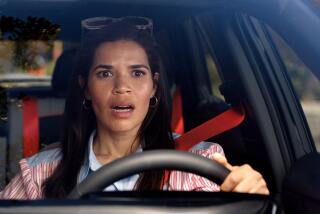Concerned Parents Push Character Movement
WASHINGTON — During the 1970s, educator Howard Kirshenbaum was a high-flying guru of the “human potential” movement--a disciple of a teaching technique known in professional circles as values clarification.
A product of the “do-your-own-thing” 1960s, values clarification invited pupils of all ages to define their own moral values, free of adult imposition, through a process of Socratic dialogue and creative resolution of ethical dilemmas.
By the late 1970s, Kirshenbaum was riding a crest of popular interest in values clarification. As a consultant, he was much in demand. As a teacher of teachers, he was known for his thoughtful and persuasive advocacy of the technique.
And then, in 1980, Howard Kirshenbaum became a parent.
With the arrival of his daughter, Kimara, Kirshenbaum caught himself actively shaping his daughter’s character, nudging her toward the qualities of kindness, tolerance and honesty that he prized--reading her little fables and praising her behavior when it conformed to his values.
Today, Kirshenbaum is a convert to the burgeoning “character education” movement, which aims to teach children in public schools right from wrong and help them--with the active intervention of adults--to understand, internalize and practice the core values of their community.
When it fails to teach the deep and abiding values of our civilization, Kirshenbaum says, “education becomes superficial to the point of frivolousness, dangerous for the survival of the best values of our culture and, ultimately, dangerous to the stability of our societies and governments.”
Kirshenbaum is not alone. Today, 62.6 million Americans have children at home, and for many of them, the freewheeling, self-actualizing 1960s and 1970s were a formative time. Many of today’s parents remember the schools of their youth as either a straitjacket of intolerance and discipline or a bubbling caldron of ferment--not a crucible in which common civic and moral virtues could or should be forged.
For many, the imposition of one’s own values on others was an act of cultural imperialism that was, well . . . a bummer.
Now, alarmed by the dangers and disorder they fear threaten their children at school, parents such as Kirshenbaum are shedding their objections to character education just as surely as they have shorn their beards and doffed their love beads.
As a result, the teaching of basic values--often called character, sometimes called virtue--has come storming back in the nation’s public schools.
The movement has flourished, according to its proponents, because many parents of school-age children, driven by fears of violence, drugs and teen pregnancy, have set aside their distrust of neighbors and educators and agreed to give public schools a role in teaching ethical principles. In the process, many have also relaxed a deeply ingrained sense that individual rights reign supreme and, like Kirshenbaum, embraced the belief that communities must share and teach their commonly held values if they are to survive.
Values Programs
In the past three years, parents and teachers have launched character education programs in school systems in cities as large Albuquerque, New York and Washington and in communities as diverse as Battle Creek, Mich., and St. Louis County, Mo.
At Annandale High School, a melting pot of Asian, Latino, African American and white students in the Virginia suburbs adjoining Washington, parents and teachers this year gave birth to a character education program based on what they call the “seven cornerstones of character”--honesty, citizenship, fairness, caring, responsibility, respect and self-discipline.
Lorraine Johnson, a math teacher at Annandale High and the parent of a senior there, was an early skeptic of the character initiative. “I thought we would be pushing our values on someone else,” said Johnson, 48, who has been teaching for 25 years. But in the months since the cornerstones of character were adopted and her colleagues began incorporating them into their lessons, Johnson has come to see them as “just common sense--the way people should behave.”
The seven virtues embraced by Annandale, Johnson added, “might seem like consensus, but it’s not clear the kids learn them at home. . . . They think it’s perfectly acceptable to cheat on a test.”
Following advice from the burgeoning industry of experts in character education, the organizers of Annandale’s program sought out parents and students early in the process to hammer out a list of virtues that all could agree on. In several sessions last summer, the committee of volunteers huddled to draft such a list.
The exercise was revealing. Although participants say the process was surprisingly free of acrimony, the exchanges offered a glimpse of the conflicting impulses of American adults as they grapple with a perceived moral crisis.
Several teachers and parents, for instance, rejected “tolerance” as a proposed cornerstone. Some argued that in a world where right is right and wrong is wrong, tolerance was just a bit too accepting. Others argued that tolerance was not quite positive enough; many minorities, for instance, wanted to be respected as well. All of those involved, however, could agree that “respect” covered the necessary territory.
Others wanted to zero in on student behavior by stiffening penalties for cheating, indiscipline and infractions of the school’s dress code. But Pat Giegerich, a 43-year veteran teacher who spearheaded Annandale’s effort, urged them to fight back the impulse to treat symptoms and argued that teaching students larger lessons about respect and responsibility would have a more lasting effect on their behavior.
“People want instant solutions,” Giegerich said. “But you can’t stop cheating unless you create people who value honesty. This is about creating a society in which people have a stake and treat people the way they would want to be treated. And discipline has to be part of that. Discipline based on coercion and threats alone is not going to work.”
Today, Giegerich’s efforts have produced a fledgling program in which good character is the touch point of many lessons.
In a class devoted to Kepler’s laws of planetary motion, for instance, physics teacher Bill Straight launches into an improbable ethics lesson over Kepler’s method of data collection: He stole it from Danish astronomer Tycho Brahe. Math teacher Carol Backman, after leading a discussion on self-respect and honesty, asks her students to sign their names at the bottom of every test, pledging that they have not given or received help in devising the answers. English teacher Jacquie Foote uses a lesson on William Golding’s “Lord of the Flies” to lead a class discussion about the qualities of leadership.
In December, school administrators organized a week of schoolwide sessions in which students split up into groups and discussed the twin virtues of respect and responsibility. Each group was led by a trained student “facilitator,” and came up with recommendations on how respect and responsibility could be fostered in their everyday dealings at school.
The effort has not transformed Annandale’s student body into paragons of virtue: Kids still cheat on tests, girls still get pregnant and some arguments still erupt into violence. But Kip Tatusko, a junior who showed an early interest in the initiative, says the class discussions have made some kids think a bit more about the ethics they know they’ve heard somewhere but observe mainly in the breach.
“They’re basic if you think about it,” says Tatusko, referring to the seven cornerstones that have become the subject of artwork in the hallways and lessons in the classroom. “But when we talk about it and think about it in class, you realize that we’re not living by them.”
Practical Lessons
Teaching students practical lessons on how to live ethically is an essential part of any character education program, says Michael Josephson of the Marina del Rey-based Character Counts! Coalition, one of the leaders of the burgeoning movement. Character educators, he adds, “want to return to times when people feel guilt and shame.”
Josephson, who has helped hundreds of school districts launch programs, observes that the movement has been propelled by a virulent backlash against the “toxic self-esteemia” that flourished in the 1960s and ‘70s--a time when many educators seemed “much more concerned with whether people liked themselves than whether they were worthy of being liked.”
That’s the kind of backlash that has driven Americans such as Greg Edward Monks, a 35-year-old independent contractor living in small-town Hugo, Colo., onto the character education bandwagon. Monks calls himself “one of the last hippies” and volunteers that as a younger man, he “hated everything about authority.” Now a father of six, including four stepchildren, he acknowledges that agreeing on what values to teach would be tough even for his rural, homogeneous town. But, he adds, it needs to be tried.
“Just common values would be a good place to start,” Monks says. “And let’s see how it works. . . . Start with the basics. If it does any good, you could see about installing some other things that could do some good.”
Since 1993, organizations devoted to the teaching of character have sprung up like mushrooms after a spring rain. Such organizations as the Character Education Partnership in Washington and the Character Counts! Coalition have developed flourishing enterprises preaching the new--and old--message that public schools have a key role in teaching children right from wrong.
Character education--a movement that before 1993 had no central clearinghouses and no visible proponents--has even won the vocal support of the main teachers’ union, the American Federation of Teachers, and the National Education Assn., as well as the blessing of national youth organizations, including the YMCA and the American Youth Soccer Organization, which claim combined membership of 3.4 million people.
The fledgling movement has won the highly visible endorsement of the First Baby Boomers, President Clinton and his wife, Hillary Rodham Clinton. The Clinton administration has funded state initiatives launching character education programs and sponsored two White House conferences on the subject. It will host another White House forum on character education in June. In January, Clinton used one of his bulliest pulpits, the State of the Union speech, to urge all schools “to teach character education: good values and good citizenship.”
In 1986, when then-New York Gov. Mario M. Cuomo called for greater emphasis on the teaching of values in public schools, the idea raised hackles among liberals. Norman Siegal, the executive director of the New York Civil Liberties Union, quickly signaled his organization’s hostility, warning that such a course could provide cover for schools teaching religion or seeking to “homogenize” what children thought.
But with Democrats and baby boomers such as the Clintons now embracing character education with gusto, educators note that the most vocal objections raised against such initiatives these days come not from liberals but from religious conservatives. After more than a decade of political activism, many such conservatives now occupy key positions on school boards and in local government, and they remember such ill-fated, “value-free” educational experiments as values clarification.
Moreover, many conservatives are offended at the idea that right and wrong would be taught as if they have no grounding in religious belief. And many more are simply deeply distrustful that the schools would intrude on an area they consider the exclusive province of churches and parents.
“The trust level among religious conservatives is so low that even the most carefully crafted character education initiative can blow up when religious beliefs and religion are not taken seriously,” says Charles Haynes, who mediates disputes over religion in schools for the Freedom Forum, based at Vanderbilt University.
George W. Fellendorf, chairman of New Hampshire’s Christian Coalition and a specialist in education, is one such skeptic. At an education forum in New Hampshire last year, he says, the top official of New Hampshire’s teachers’ union told him that if children come to school with different values than those they are taught at school, teachers should encourage the kids to discard the lessons their parents are teaching.
“When someone makes a statement like that, I get very, very nervous,” he says. “It really does make me wary of public schools’ efforts. . . . When you get into a discussion of virtues, I’m inclined to think the schools ought to keep their hands off--that’s a role for parents and churches.”
Role for Schools
Public opinion polls indicate broad support for the basic tenets of character education. At the same time, they reveal a lingering distrust of schools’ role in inculcating values.
A 1994 Gallup poll conducted for the Phi Delta Kappan, a magazine for teachers, showed that 49% of Americans think that courses on values and ethical behavior should be taught in public schools--up from 43% in 1987, with another 12% volunteering that both parents and schools should teach values. Among parents with children in public school, support for such education was 57%. Yet 39% responded that teaching such values should be the province of parents or churches.
Asked whether such “virtues” as respect for others, industry, persistence, fairness, compassion and civility should be taught in public schools, the response was far less muted. More than 90% of respondents said public schools should teach these traits.
Why would parents from across the political spectrum drop their distrust of authority and of each other and agree to accept a role for public schools in shaping their children’s ethics?
Increasingly, says Thomas Lickona, author of the book “Educating for Character,” American parents and teachers--especially teachers--have the sense that “the bottom is sort of dropping out of our moral culture.”
Lickona cites the widely reported experience of longtime teachers who ask their students to write down the Golden Rule: Do unto others as you would have them do unto you. In many classrooms, teachers tell Lickona, the question draws a blank from virtually every student in the room.
But the character education movement also has flourished because the movement’s champions have disarmed potential critics by focusing on core values such as respect, responsibility, compassion, trustworthiness and honesty--virtues that few people, especially parents, would object to.
“The debates over ‘Whose values? What values?’ was once a death knell” for efforts to teach character in the public schools, says Josephson, who is also president of the Josephson Institute of Ethics in Marina del Rey. “And now, we go into a community and it’s ‘How? When?’ ”
Josephson is a former law professor with a messianic mission to improve the ethical climate of the nation. He hawks his “six pillars of character”--trustworthiness, respect, responsibility, fairness, caring and citizenship--as aggressively as an itinerant management consultant selling the latest wrinkle in productivity.
Like Kirshenbaum, Josephson’s moral epiphany started with a child--his son, Justin.
“When I graduated from UCLA law school in 1967, the only value I fiercely believed in was that it was wrong to be judgmental,” Josephson says. “I only got into ethics because I was assigned to teach an ethics course in 1976, and I had a child the same year. . . . All of a sudden, the emptiness and the bankruptcy of this complete nonjudgmentalness became blindingly obvious.”
Josephson acknowledges that among the toughest questions he must confront is when parents ask whether this is not their domain.
“The answer is, absolutely! But some parents really need help, because you can’t always do it alone.” And let’s face it, he adds, “some parents are doing a lousy job.”
That’s an argument that Agnes Shelton of Greeneville, Tenn., a 32-year-old mother of two, finds persuasive. A married homemaker struggling to raise her own kids and help with two nephews she describes as neglected, Shelton agrees that teaching values is a parent’s job. But she knows how stretched life becomes when both parents work, and she knows from her nephews’ experience that plenty of parents are failing entirely.
“You may offend people” by suggesting public schools have a role in teaching values, Shelton acknowledges. But, she adds, “I’ve raised my children right, and maybe there’s something I’ve overlooked. I ain’t saying I’m perfect.”







